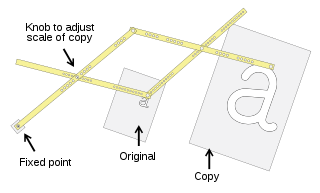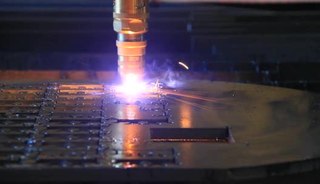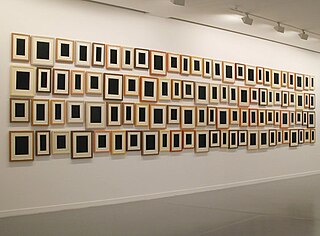 Six Shapes from The Shapes Project
Six Shapes from The Shapes Project The Shapes Project is a combinatorial system designed by the American artist Allan McCollum, in 2005-2006, to produce unique two-dimensional "shapes." The system allows for the making of enough unique shapes for every person on the planet to have one of their own. It also allows the shapes to be kept track of in such a way as to ensure that no two will ever be alike. [1]
Following the present rate of birth, it is generally estimated that the world population will grow until it "peaks" in the middle of the present century, and then possibly begin to decline. How many people will be alive at this peak are estimated at between 8 billion and 20 billion people, depending upon what factors are considered and who is doing the considering. The most recent estimate published by the United Nations puts the figure at around 9.2 billion in the year 2050. [2]
To make certain that the system will be able to accommodate everyone, it has been organized to produce over 31,000,000,000 different shapes, which is more than the highest population estimates might require.
 Shape, from The Shapes Project, carved from Corian, with CNC milling equipment.
Shape, from The Shapes Project, carved from Corian, with CNC milling equipment. For the time being, the potential for producing around 214,000,000 of the shapes have been set aside for creative experimentation. These can be used for many different purposes—not only for fine art and design projects, but also for various social practices: as gifts, awards, identity markers, emblems, insignias, logos, toys, souvenirs, educational games, and so forth.
So far, only home computers have been used to construct Adobe Illustrator vector graphics files that allow the shapes to be produced in many possible ways. The shapes can be printed graphically as silhouettes or outlines, in any size, color or texture, using all varieties of graphics software; or, the files can be used by rapid prototyping machines and computer-numerically-controlled (CNC) equipment—such as routers, laser cutters and waterjet cutters—to build, carve, or cut the shapes from wood, plastic, metal, stone, and other materials. [3]
The basic system for making the shapes has been completed, but the project of actually constructing all of them is much too large for any one person to finish in any single person's lifetime. For this reason, the project has been organized in such a way that others may continue completing them in the artist's absence. The shapes are also being made available to others, with the hope that people will come up with many interesting ways to use them. [4]
In 2007, The Museum of Modern Art acquired 432 of the "Shapes" for its permanent collection. [5]

A pantograph is a mechanical linkage connected in a manner based on parallelograms so that the movement of one pen, in tracing an image, produces identical movements in a second pen. If a line drawing is traced by the first point, an identical, enlarged, or miniaturized copy will be drawn by a pen fixed to the other. Using the same principle, different kinds of pantographs are used for other forms of duplication in areas such as sculpture, minting, engraving, and milling.

Computer-aided design (CAD) is the use of computers to aid in the creation, modification, analysis, or optimization of a design. This software is used to increase the productivity of the designer, improve the quality of design, improve communications through documentation, and to create a database for manufacturing. Designs made through CAD software are helpful in protecting products and inventions when used in patent applications. CAD output is often in the form of electronic files for print, machining, or other manufacturing operations. The terms computer-aided drafting (CAD) and computer aided design and drafting (CADD) is also used.

The router is a power tool with a flat base and a rotating blade extending past the base. The spindle may be driven by an electric motor or by a pneumatic motor. It routs an area in hard material, such as wood or plastic. Routers are used most often in woodworking, especially cabinetry. They may be handheld or affixed to router tables. Some woodworkers consider the router one of the most versatile power tools.

A machinist is a tradesperson or trained professional who not only operates machine tools, but also has the knowledge of tooling and materials required to create set ups on machine tools such as milling machines, grinders, lathes, and drilling machines.

Population growth is the increase in the number of people in a population or dispersed group. Global human population growth amounts to around 83 million annually, or 1.1% per year. The global population has grown from 1 billion in 1800 to 7.9 billion in 2020. The UN projected population to keep growing, and estimates have put the total population at 8.6 billion by mid-2030, 9.8 billion by mid-2050 and 11.2 billion by 2100. However, some academics outside the UN have increasingly developed human population models that account for additional downward pressures on population growth; in such a scenario population would peak before 2100.

A CNC wood router is a CNC router tool that creates objects from wood. CNC stands for computer numerical control. The CNC works on the Cartesian coordinate system for 3D motion control. Parts of a project can be designed in the computer with a CAD/CAM program, and then cut automatically using a router or other cutters to produce a finished part. The CNC router is ideal for hobbies, engineering prototyping, product development, art, and production work.

Plasma cutting is a process that cuts through electrically conductive materials by means of an accelerated jet of hot plasma. Typical materials cut with a plasma torch include steel, stainless steel, aluminum, brass and copper, although other conductive metals may be cut as well. Plasma cutting is often used in fabrication shops, automotive repair and restoration, industrial construction, and salvage and scrapping operations. Due to the high speed and precision cuts combined with low cost, plasma cutting sees widespread use from large-scale industrial CNC applications down to small hobbyist shops.

A Tool and Cutter Grinder is used to sharpen milling cutters and tool bits along with a host of other cutting tools.

Human overpopulation is the concept of a human population becoming too large to be sustained by its environment or resources in the long term. The idea is usually discussed in the context of world population, though it may also concern regions. Human population growth has increased in recent centuries due to medical advancements and improved agricultural productivity. Those concerned by this trend argue that it results in a level of resource consumption which exceeds the environment's carrying capacity, leading to population overshoot. The concept is often discussed in relation to other population concerns such as demographic push and depopulation, as well as in relation to resource depletion and the human impact on the environment.

Allan McCollum is a contemporary American artist who lives and works in New York City. In 1975, his work was included in the Whitney Biennial, and he moved to New York City the same year. In the late 1970s he became especially well known for his series, Surrogate Paintings.

This article lists current estimates of the world population in history. In summary, estimates for the progression of world population since the Late Middle Ages are in the following ranges:
Digital modeling and fabrication is a design and production process that combines 3D modeling or computing-aided design (CAD) with additive and subtractive manufacturing. Additive manufacturing is also known as 3D printing, while subtractive manufacturing may also be referred to as machining, and many other technologies can be exploited to physically produce the designed objects.

In demographics, the term world population is often used to refer to the total number of humans currently living, and was estimated to have exceeded 7.9 billion as of November 2021. It took over two million years of human prehistory and history for the human population to reach one billion and only 207 years more to grow to 7 billion.

A computer numerical control (CNC) router is a computer-controlled cutting machine which typically mounts a hand-held router as a spindle which is used for cutting various materials, such as wood, composites, metals, plastics, glass, and foams. CNC routers can perform the tasks of many carpentry shop machines such as the panel saw, the spindle moulder, and the boring machine. They can also cut joinery such as mortises and tenons.

Christian population growth is the population growth of the global Christian community. According to a 2011 Pew Research Center survey, there were more than 2.2 billion Christians around the world in 2010, more than three times as many as the 600 million recorded in 1910. However, this rate of growth is slower than the overall population growth over the same time period.
Earth has a human population of 8 billion, with an overall population density of 50 people per km2, excluding Antarctica. Nearly 60% of the world's population lives in Asia, with almost 2.8 billion in the countries of China and India combined. The percentage share of India, China and rest of South Asia in world population have remained on similar levels for the last few thousands years of recorded history. The world's literacy rate has increased dramatically in the last 40 years, from 66.7% in 1979 to 86.3% today. Lower literacy levels are mostly attributable to poverty. Lower literacy rates are mostly found in South Asia and Sub-Saharan Africa. The world's largest ethnic group is Han Chinese, with Mandarin being the world's most spoken language in terms of native speakers.

Population projections are attempts to show how the human population statistics might change in the future. These projections are an important input to forecasts of the population's impact on this planet and humanity's future well-being. Models of population growth take trends in human development, and apply projections into the future. These models use trend-based-assumptions about how populations will respond to economic, social and technological forces to understand how they will affect fertility and mortality, and thus population growth.

World population milestones went unnoticed until the 20th century, since there was no reliable data on global population dynamics.

Milling is the process of machining using rotary cutters to remove material by advancing a cutter into a workpiece. This may be done by varying direction on one or several axes, cutter head speed, and pressure. Milling covers a wide variety of different operations and machines, on scales from small individual parts to large, heavy-duty gang milling operations. It is one of the most commonly used processes for machining custom parts to precise tolerances.

Sustainable population refers to a proposed sustainable human population of Earth or a particular region of Earth, such as a nation or continent. Estimates vary widely, with estimates based on different figures ranging from 0.65 billion people to 98 billion, with 8 billion people being a typical estimate. Projections of population growth, evaluations of overconsumption and associated human pressures on the environment have led to some to advocate for what they consider a sustainable population. Proposed policy solutions vary, including sustainable development, female education, family planning and broad human population planning.



















